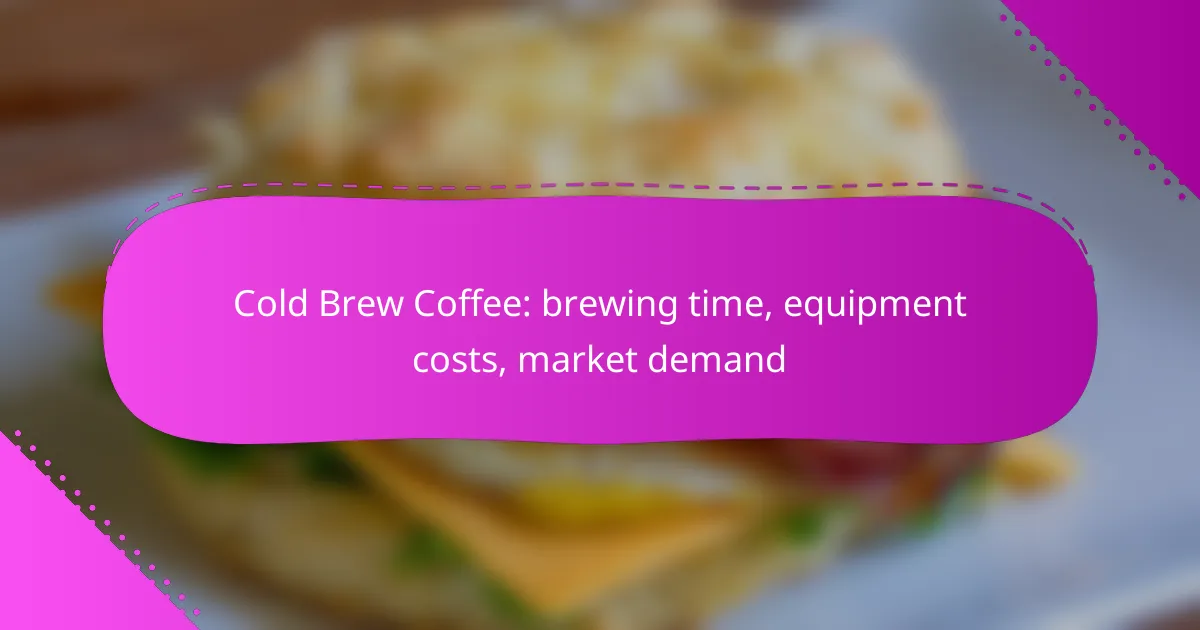Cold brew coffee has gained popularity for its smooth, less acidic flavor, achieved by steeping coarsely ground coffee in cold water for 12 to 24 hours. Essential equipment for brewing includes cold brew coffee makers or alternative devices that facilitate this extended steeping process. As consumer demand rises, particularly in warmer months, cold brew is becoming a preferred choice for those seeking refreshing coffee alternatives.

How to brew cold brew coffee effectively?
To brew cold brew coffee effectively, steep coarsely ground coffee in cold water for an extended period, typically between 12 to 24 hours. This method produces a smooth, less acidic coffee concentrate that can be diluted to taste.
Brewing time of 12-24 hours
The brewing time for cold brew coffee is crucial for achieving the desired flavor profile. A steeping period of 12 to 24 hours allows the coffee to extract its rich flavors without the bitterness often associated with hot brewing methods.
If you prefer a stronger concentrate, aim for the longer end of the range. Conversely, a shorter steeping time may yield a milder flavor, which can be adjusted by varying the coffee-to-water ratio.
Recommended coffee-to-water ratio
The ideal coffee-to-water ratio for cold brew typically ranges from 1:4 to 1:8, depending on your taste preference. A common starting point is 1:5, which balances strength and smoothness.
Experiment with different ratios to find your perfect brew. For instance, if you use 100 grams of coffee, mix it with 500 to 800 milliliters of water. Adjusting this ratio can help you achieve the desired intensity and flavor.
Best brewing methods
There are several effective methods for brewing cold brew coffee, including immersion and slow drip. The immersion method involves combining coffee grounds and water in a container, letting it steep, and then filtering it out.
The slow drip method uses a specialized cold brew maker that drips water over coffee grounds slowly, extracting flavors over time. Both methods can produce excellent results, so choose one that fits your equipment and preferences.
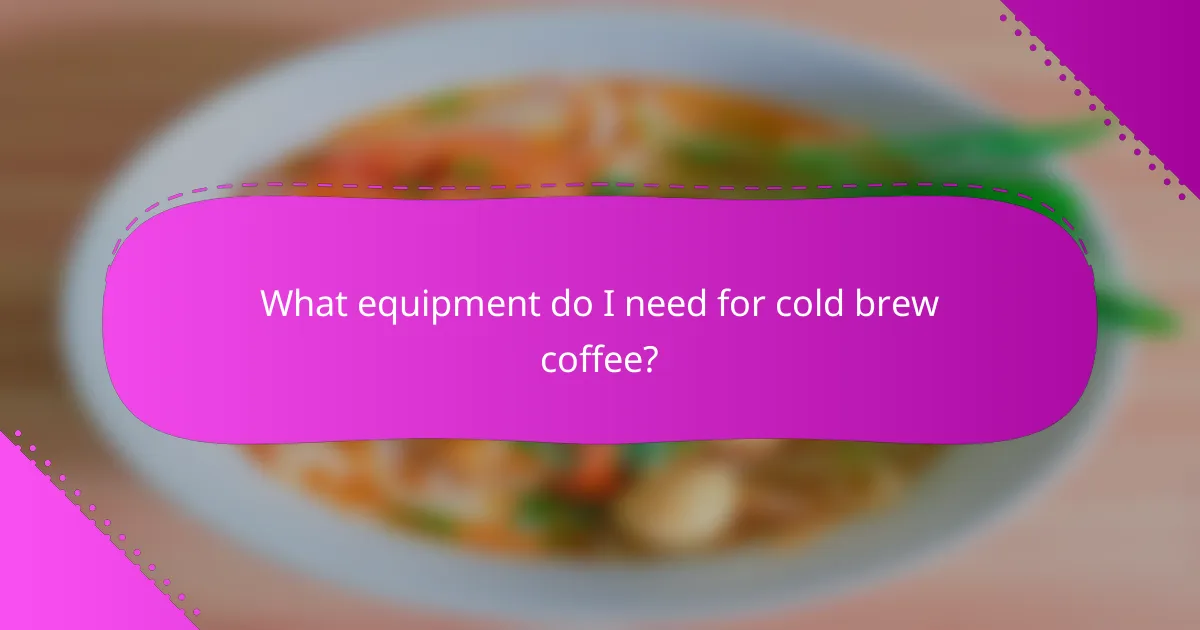
What equipment do I need for cold brew coffee?
To make cold brew coffee, you need a few essential pieces of equipment that facilitate the brewing process. The most common tools include a cold brew coffee maker or alternative brewing devices, which allow for steeping coffee grounds in cold water over an extended period.
Cold brew coffee makers
Cold brew coffee makers are specifically designed for brewing coffee using cold water. These devices typically feature a brewing chamber and a filtration system to separate the coffee grounds from the liquid. Popular models include the Takeya Cold Brew Maker and the OXO Good Grips Cold Brew Coffee Maker, which are user-friendly and efficient.
When choosing a cold brew coffee maker, consider factors such as capacity, ease of cleaning, and brewing time. Most makers can brew coffee in 12 to 24 hours, depending on your taste preference.
Alternative brewing tools
If you don’t want to invest in a dedicated cold brew coffee maker, you can use alternative tools like a French press or a mason jar. With a French press, simply add coarsely ground coffee and cold water, let it steep for 12 to 24 hours, and then press the plunger to separate the grounds.
A mason jar can also work well; combine coffee and water, let it steep, and then strain the mixture through a fine mesh sieve or coffee filter. These methods are cost-effective and can yield great results.
Cost of equipment in New Zealand
The cost of cold brew coffee equipment in New Zealand can vary widely based on the type and brand. A dedicated cold brew coffee maker typically ranges from NZD 30 to NZD 150, while alternative brewing tools like French presses or mason jars are generally more affordable, often costing between NZD 10 and NZD 50.
When budgeting for your cold brew setup, consider the long-term savings from making coffee at home compared to purchasing ready-made cold brew from cafes, which can be significantly more expensive. Investing in quality equipment can enhance your brewing experience and improve the taste of your coffee.

What is the market demand for cold brew coffee in New Zealand?
The market demand for cold brew coffee in New Zealand has been steadily increasing as consumers seek refreshing alternatives to traditional coffee. This trend is driven by a growing preference for cold beverages, especially during warmer months, and an increasing awareness of the unique flavor profiles that cold brew offers.
Growth trends in cold brew coffee sales
Cold brew coffee sales in New Zealand have seen significant growth over the past few years, with many cafes and retailers expanding their offerings. This growth is attributed to the rising popularity of specialty coffee and the convenience of ready-to-drink cold brew options. Industry reports suggest that sales could continue to rise as more consumers discover the benefits of cold brew.
Additionally, the introduction of cold brew coffee in various formats, such as bottled beverages and coffee pods, has made it more accessible to a wider audience. This diversification in product offerings is likely to further boost market demand.
Consumer preferences and demographics
Consumer preferences for cold brew coffee in New Zealand are largely driven by younger demographics, particularly millennials and Gen Z, who favor innovative and trendy beverage options. These groups are more inclined to experiment with different flavors and brands, leading to a vibrant market for cold brew products.
Moreover, health-conscious consumers are drawn to cold brew coffee for its lower acidity compared to traditional coffee, making it easier on the stomach. This aspect, combined with the appeal of cold brew as a refreshing drink, positions it well within the growing market for healthier beverage choices.
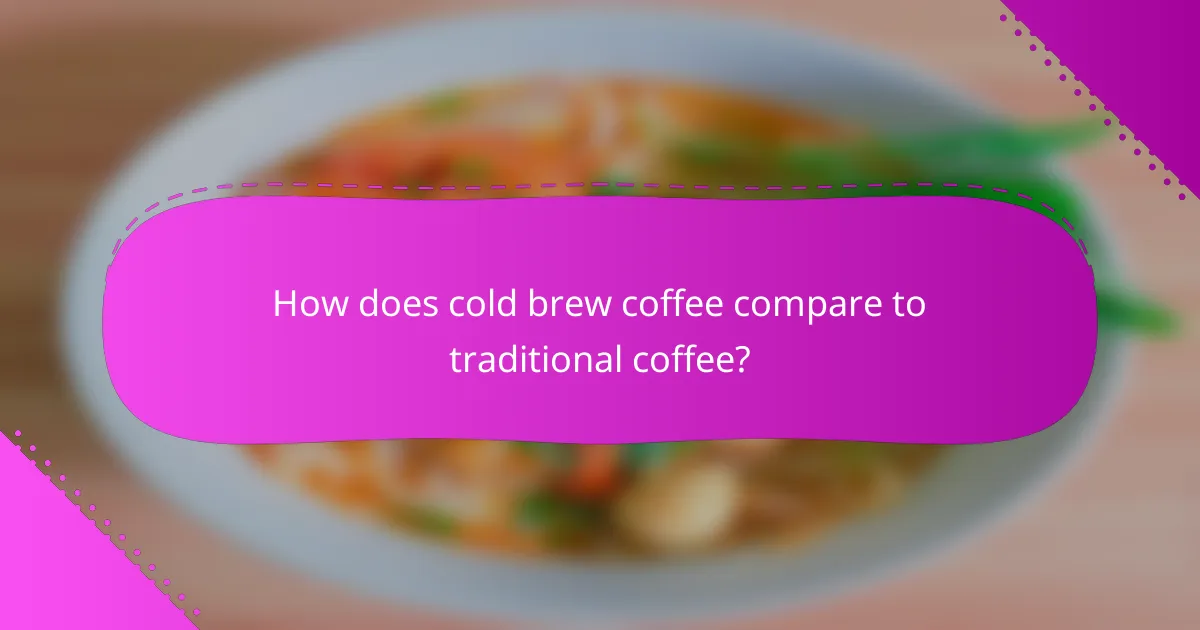
How does cold brew coffee compare to traditional coffee?
Cold brew coffee differs from traditional coffee primarily in its brewing method, resulting in distinct flavors and caffeine levels. While traditional coffee is brewed with hot water, cold brew uses cold or room temperature water over an extended period, typically leading to a smoother taste and lower acidity.
Flavor profile differences
The flavor profile of cold brew coffee is generally smoother and less acidic than that of traditional coffee. This is due to the cold extraction process, which minimizes the release of bitter compounds. Many drinkers describe cold brew as having chocolatey or nutty notes, making it a popular choice for those who prefer a milder taste.
In contrast, traditional coffee often has a brighter, more pronounced acidity and can exhibit a wider range of flavors depending on the brewing method and bean type. The heat used in brewing extracts different oils and acids, contributing to a more complex flavor profile.
Caffeine content comparison
Cold brew coffee typically contains higher caffeine levels per ounce compared to traditional coffee. However, serving sizes differ; cold brew is often diluted with water or milk before consumption, which can lower the overall caffeine intake per cup.
For example, a standard serving of cold brew may have around 200-300 mg of caffeine, while an 8-ounce cup of traditional coffee usually contains about 95-200 mg. When considering caffeine content, it’s essential to factor in the serving size and dilution methods used for cold brew.
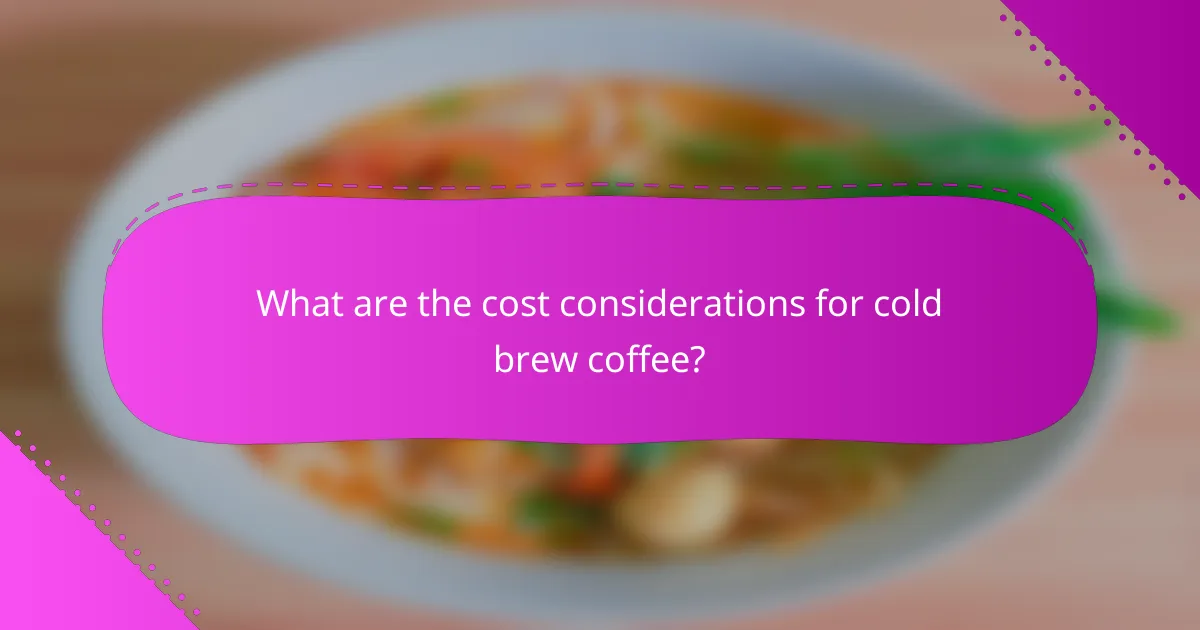
What are the cost considerations for cold brew coffee?
Cost considerations for cold brew coffee include ingredient expenses and equipment investments. Understanding these factors can help you budget effectively whether you’re brewing at home or running a café.
Ingredient costs
The primary ingredients for cold brew coffee are coarsely ground coffee beans and water. High-quality coffee beans can range from $10 to $20 per pound, depending on the origin and roast. For a typical batch, you might use about 1 cup of coffee grounds, translating to a cost of roughly $1 to $2 per batch.
Water is generally inexpensive, but if you opt for filtered or bottled water, this could add a few cents to your overall cost. Additionally, if you choose to flavor your cold brew with syrups or milk, factor in those expenses, which can vary widely based on brand and quality.
Equipment investment
To brew cold brew coffee, you need a few essential pieces of equipment. A large jar or pitcher is necessary for steeping, which can cost anywhere from $10 to $30. Alternatively, you can purchase a dedicated cold brew coffee maker, which typically ranges from $20 to $50.
Consider also the cost of a coffee grinder if you do not already own one. A decent grinder can range from $20 to $100. Overall, your initial investment for equipment can vary from about $30 to $150, depending on the quality and type of tools you choose.
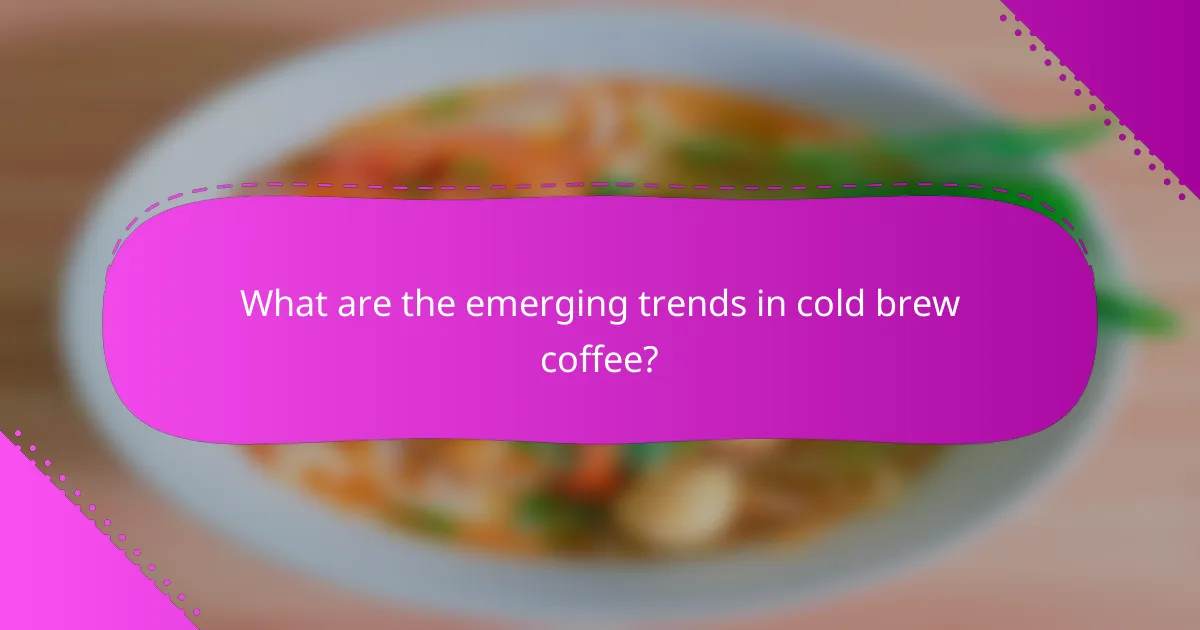
What are the emerging trends in cold brew coffee?
Emerging trends in cold brew coffee highlight innovative flavors, convenient ready-to-drink formats, and increasing consumer demand. As more coffee drinkers seek unique experiences, the market is evolving to include diverse options that cater to various tastes and lifestyles.
Innovative flavors and blends
Cold brew coffee is increasingly available in a variety of innovative flavors and blends, appealing to adventurous consumers. Popular options include vanilla, mocha, and seasonal spices, often enhanced with natural sweeteners or dairy alternatives. This trend allows brands to differentiate themselves and attract a broader audience.
Additionally, some companies are experimenting with infusions, such as fruit or herbal notes, creating unique flavor profiles that stand out in the market. These innovative blends not only enhance the drinking experience but also cater to specific dietary preferences, such as vegan or gluten-free options.
Cold brew coffee in ready-to-drink formats
The ready-to-drink (RTD) cold brew coffee segment is rapidly growing, driven by consumer demand for convenience. Many brands now offer bottled or canned cold brew options that are easy to grab on-the-go, making it a popular choice for busy lifestyles. These products often come in various flavors and strengths, catering to different preferences.
As the RTD market expands, companies are focusing on quality ingredients and sustainable packaging to appeal to environmentally conscious consumers. This shift not only meets consumer expectations but also positions brands favorably in a competitive landscape, where quality and convenience are paramount.
